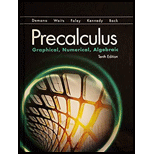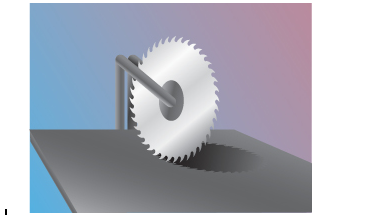
To identify: how many teeth cross the cutting surface each second.
The teeth cross the cutting surface each second is
Given information:
A radial arm saw has a circular cutting blade with a diameter of 10 in. It spins at 2000 rpm. If there are 12 cutting teeth per inch on the cutting blade.

Explanation:
To determine how many teeth cross the cutting surface each second by a radial arm saw which has a circular cutting blade with a diameter of 10inches and it spins at 2000 revolutions per minute (rpm), if it has 12 cutting teeth per inch on the cutting blade
Recall that circumference of a circle is
where r is the radius of the circle:
Therefore, circumference C of the circular cutting blade is equal to:
Then total number of blades on the circumference of the circular cutting blade will be:
As, there are 12cutting teeth per inch on the cutting blade.
As the circular blade spins at 2000 revolutions per minute (rpm).
Convert 2000 revolution per minute (rpm) to revolution per second (rps)by dividing it by 60 as 1 minute is equal to 60 seconds.
Thus,
Hence number to teeth crossing the cutting surface each second is equal to
Chapter 4 Solutions
EBK PRECALCULUS:GRAPHICAL,...-NASTA ED.
 Calculus: Early TranscendentalsCalculusISBN:9781285741550Author:James StewartPublisher:Cengage Learning
Calculus: Early TranscendentalsCalculusISBN:9781285741550Author:James StewartPublisher:Cengage Learning Thomas' Calculus (14th Edition)CalculusISBN:9780134438986Author:Joel R. Hass, Christopher E. Heil, Maurice D. WeirPublisher:PEARSON
Thomas' Calculus (14th Edition)CalculusISBN:9780134438986Author:Joel R. Hass, Christopher E. Heil, Maurice D. WeirPublisher:PEARSON Calculus: Early Transcendentals (3rd Edition)CalculusISBN:9780134763644Author:William L. Briggs, Lyle Cochran, Bernard Gillett, Eric SchulzPublisher:PEARSON
Calculus: Early Transcendentals (3rd Edition)CalculusISBN:9780134763644Author:William L. Briggs, Lyle Cochran, Bernard Gillett, Eric SchulzPublisher:PEARSON Calculus: Early TranscendentalsCalculusISBN:9781319050740Author:Jon Rogawski, Colin Adams, Robert FranzosaPublisher:W. H. Freeman
Calculus: Early TranscendentalsCalculusISBN:9781319050740Author:Jon Rogawski, Colin Adams, Robert FranzosaPublisher:W. H. Freeman
 Calculus: Early Transcendental FunctionsCalculusISBN:9781337552516Author:Ron Larson, Bruce H. EdwardsPublisher:Cengage Learning
Calculus: Early Transcendental FunctionsCalculusISBN:9781337552516Author:Ron Larson, Bruce H. EdwardsPublisher:Cengage Learning





